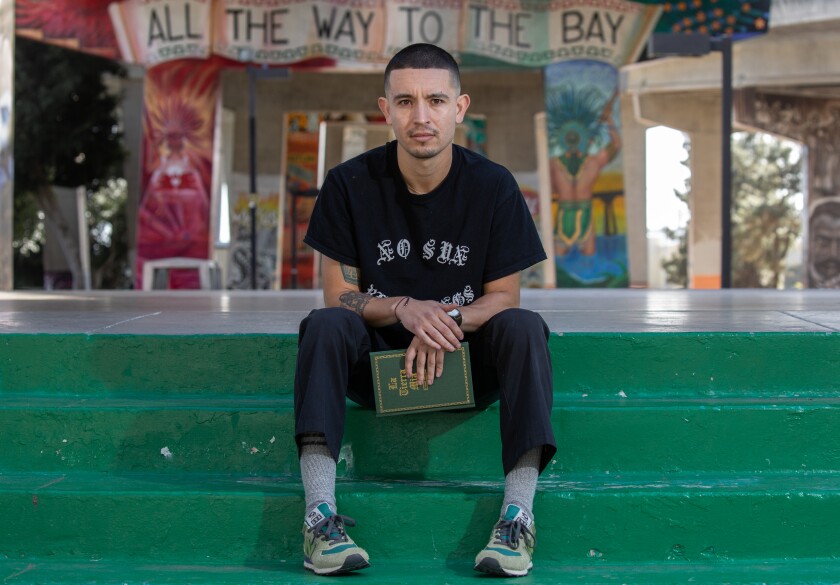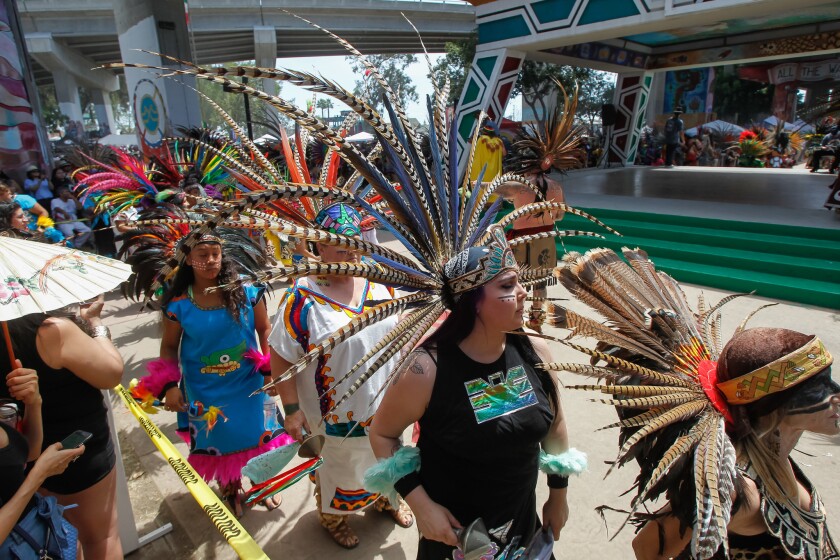For those who grew up in Barrio Logan and several surrounding communities, it’s a given to participate in one of the largest celebrations in the area — Chicano Park Day.
Chicano Park is nestled under the San Diego-Coronado bridge in Barrio Logan, a community located south of downtown. The freeway’s concrete pillars over the park, a national historic landmark, are covered with dozens of colorful murals that depict Chicano culture, leaders and movements.
Chicano Park Day is an annual celebration that typically takes place in April. There’s music, food and Aztec dancers. It’s a celebration of the anniversary of the park’s “takeover,” a protest held by activists and residents who fought to keep the city from building a highway patrol station at the site in 1970.
Former Logan Heights resident Bob Dominguez was one of thousands who attended Chicano Park Day every year with family and friends when he was a little boy.
The memories of the park have stayed with him over the years, and they were the driving force behind “La Tierra Mia: A Chicano Park Story,” a photo book that chronicles the park’s foundation and numerous celebrations over the last 50 years.

Author, Bob Dominguez sits at the Kiosko in Chicano Park with his book La Tierra Mia Book on Monday, March 22, 2021 in San Diego, CA.
(Jarrod Valliere / The San Diego Union-Tribune)
Dominguez is set to release a second edition next week. It will include additional images and short notes from individuals in the photographs.
“Having a physical archive of Chicano resistance, pride, and joy is ultimately something I think can have a lasting cultural impact, particularly in a world where so many things are fleeting,” Dominguez said. “Maybe through these artifacts of the past we can start to formulate some idea for how we build our future within the community and beyond.”
Dominguez collaborated with dozens of activists, artists and residents to build a collection of photographs for the book. Some of the images are from 1970 and were provided by special collections and archives belonging to muralists and activists.
Others are by seven local photographers who took photos of recent Chicano Park Day celebrations. The photographers include Fedella Lizeth, Bianca Gonzalez, Valeria Carranza, Angelica Grijalva, Arturo Cano, Chata and Joshua Sanchez.
Lizeth, who lives in City Heights but works in Barrio Logan, contributed three images to the book. Lizeth grew up in surrounding communities, but it was a family tradition to attend Chicano Park Day every year because it was a celebration of Latino culture in San Diego, she said.
“The park itself radiates resiliency,” she said. “Smelling all the sage, hearing the car horns, while you’re under the freeway bridge ... it’s a really surreal experience. It’s a celebration of survival and being present.”
The book has images of residents breaking down dirt to plant flowers, muralists on scaffolding painting murals, residents protesting junk yards in the community, people crowding lowriders and families enjoying the park.
It also includes notes from people in the photographs about their memories and connections to the park.
There’s a note from Julia Torres, a member of the first group of female muralists at the park; community activist Herman Baca and car enthusiast David Aguilar. All share a specific memory of the park in their words.
“We were the first group of women to paint a mural in San Diego,” Torres wrote. “We witnessed the Chicano Movement at the Chicano Park during the late 70s. We believed that this was very important and that some day this movement would make a difference.
She still lives in San Diego and passes by Chicano Park once in a while “just to look at our mural,” she wrote.

Crowds enjoy a Danza Azteca performance on Chicano Park Day in 2017.
(Eduardo Contreras/The San Diego Union-Tribune)
Dominguez said the park has always been a community space that represents the resiliency of the neighborhood. He grew up near the park and often played at the basketball courts.
Now he lives in New York but visits often.
“As a child you’re not able to contextualize how special it is,” Dominguez said. “But actually this is such a foundational piece to the community.”
Last year Chicano Park Day’s 50th celebration was canceled because of the pandemic. This year there will be a virtual celebration, “Chicano Park 51: Healing Our Past, Educating the Present, Leading into our Future,” from April 19 through 24.
The first edition of the book was released in October 2020 and sold about 500 copies.
The second edition will sell for $60. Part of the proceeds will go to the Chicano Park Steering Committee, a grassroots organization that oversees events and activities at the park.
Lee esta historia en español, haz clic aquí.
"book" - Google News
March 29, 2021 at 07:00PM
https://ift.tt/31A1UgR
'La Tierra Mia: A Chicano Park Story' photo book captures landmark's history - pacificsandiego.com
"book" - Google News
https://ift.tt/2Yv0xQn
https://ift.tt/2zJxCxA
Bagikan Berita Ini














0 Response to "'La Tierra Mia: A Chicano Park Story' photo book captures landmark's history - pacificsandiego.com"
Post a Comment